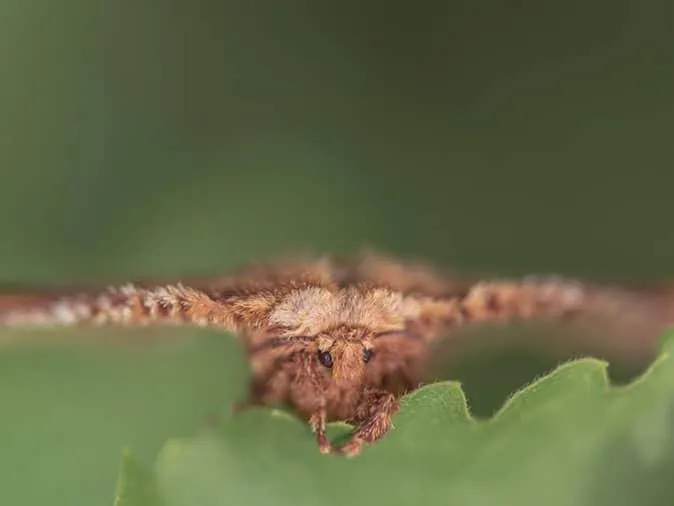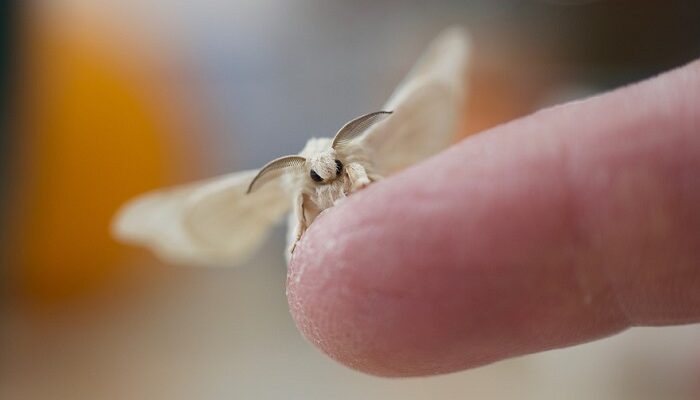Yes, moths do sleep, but their sleep patterns and behaviors are different from those of humans and some other animals. Moths are typically nocturnal creatures, meaning they are most active at night and rest during the day. Their sleep is often referred to as “diurnal torpor.”
During the day, moths often seek shelter to rest and conserve energy. They may find a concealed spot in vegetation or other protected areas to rest and avoid predators. While in this state, their metabolic rate decreases, and they become less responsive to external stimuli, similar to a state of rest or sleep.
How do moths’ antennae aid in their behavior?
Moths, like all insects, have a highly specialized body structure that plays a crucial role in their daily activities, including sleep. Here are some key aspects of moth body structure:
Moths, like other insects, have an exoskeleton, which is a hard, protective outer covering made of chitin. This exoskeleton provides support and protection to the moth’s internal organs.
Moreover, a moth’s body is divided into three main segments: the head, thorax, and abdomen. Each segment serves specific functions in the moth’s life processes.
One of the most distinctive features of moths is their wings. Moths have two pairs of wings covered in scales, which give them their characteristic patterns and colors. These wings are essential for their flight and mate attraction.
Moths have various types of mouthparts depending on their diet. Some have long proboscises for feeding on nectar, while others have mandibles for consuming solid food.
Furthermore, moths have six jointed legs attached to their thorax. These legs are equipped with claws and other structures that allow them to cling to surfaces.
Moths have sensory hairs, called setae, located throughout their bodies. These setae help moths detect changes in their environment, including changes in temperature and humidity.
Role of the Brain in Moth Behavior

The moth’s brain, while relatively small compared to mammals, plays a crucial role in governing their behavior, including sleep patterns. Moth brains consist of several interconnected ganglia or nerve clusters. Here’s a closer look at the brain’s role:
The moth’s brain controls essential behaviors such as flight, mating, feeding, and sleep. It receives and processes sensory information from the environment to make decisions related to these behaviors.
Hence, the moth’s brain houses an internal clock that regulates circadian rhythms, including sleep-wake cycles. This clock helps moths synchronize their activities with day-night cycles.
Moreover, the brain integrates information from various sensory organs, including antennae and eyes, to make decisions about behavior. For example, it can detect pheromone signals from potential mates and navigate towards them.
While moths may not have complex cognitive abilities like mammals, their brains are capable of some level of learning and memory. This allows them to adapt their behavior based on past experiences.
What are the key characteristics of moth sleep patterns?
Understanding the sleep patterns of moths is essential to comprehend their behavior and adaptations. Moths exhibit intriguing sleep patterns that differ from those of mammals and birds. Here’s a detailed description of moth sleep patterns:
Most moths are nocturnal, meaning they are primarily active during the night. Their sleep-wake cycles are reversed compared to diurnal creatures, and they’ve evolved various mechanisms to thrive in low-light conditions.
Some moths are crepuscular, meaning they are most active during dawn and dusk. This behavior allows them to take advantage of the transition between day and night when light levels are optimal for their activities.
During the daytime or when not actively searching for mates or food, moths typically rest in concealed locations, such as under leaves or bark. This period of rest is akin to their “sleep” and serves to conserve energy.
When moths are in their resting or “sleeping” state, their metabolic rate decreases, and they exhibit reduced movement. This conservation of energy is essential because moths often face challenges in finding food and avoiding predators.
Wakefulness for Reproduction: Moths become most active and alert when it’s time to reproduce. They release pheromones to attract mates and engage in complex courtship behaviors. This reproductive activity is a crucial part of their sleep-wake cycle.
Variability in Sleep Duration among Different Moth Species
Sleep duration can vary significantly among different moth species, reflecting their specific ecological niches and adaptations. Here are some factors contributing to this variability:
Life Stage: Moth sleep patterns can change throughout their life cycle. For instance, caterpillars and pupae have different sleep patterns compared to adult moths.
Seasonal Variation: Moth sleep duration may vary seasonally, with some species having shorter sleep periods during the breeding season when they are more active.
Habitat and Diet: Moths in different habitats and with different diets may exhibit distinct sleep patterns. For example, moths in urban environments exposed to artificial light may have altered sleep patterns compared to those in natural settings.
Predator Pressure: Moths facing higher predator pressure may have shorter sleep durations, as they need to be more vigilant to avoid predation.
How does light impact moth sleep?
Light is a crucial environmental factor that significantly affects moth sleep patterns:
Moths have evolved to be highly sensitive to natural light cycles, primarily moonlight and starlight. They use these cues to navigate and time their activities. Artificial light sources, such as streetlights and buildings, can disrupt these natural cues and lead to altered sleep patterns.
Many moths exhibit phototaxis, which means they are attracted to light sources. This behavior can be detrimental as moths may become disoriented, expend unnecessary energy, and become more vulnerable to predation when they are drawn to artificial lights.
Moths are adapted to low light conditions, and their eyes are specialized for gathering as much available light as possible. They tend to be more active during the night when their vision is most effective.
Temperature and Moth Sleeping Patterns
Temperature plays a vital role in regulating moth sleep patterns:
Moths are ectothermic creatures, meaning their body temperature is influenced by their environment. When temperatures drop, moths enter a state of torpor, which is similar to hibernation. During torpor, their metabolic rate decreases, and they become less active, conserving energy.
Some moths can adjust their body temperature by changing their posture and orientation relative to heat sources like the sun. They may bask in sunlight to warm up and become more active during cool periods.
Moths often synchronize their activity with daily temperature fluctuations. They may become more active when temperatures are favorable for flight and foraging.
Predators and Moth Defensive Mechanisms during Sleep
Moths have developed several defensive mechanisms to protect themselves from predators during sleep:
Many moths have evolved to have coloration and patterns that help them blend into their surroundings. This camouflage reduces the chances of being detected by visually hunting predators during rest.
Moths’ primarily nocturnal activity reduces their exposure to diurnal predators, such as birds. This reduces the risk of predation during their vulnerable resting periods.
Some moths have developed behaviors that make them less vulnerable to predators during rest. For example, they may position themselves in a way that minimizes their silhouette, making it harder for predators to spot them.
What is the evolutionary significance of moth sleep?
To understand the evolutionary origins of moth sleep behavior, we must consider their ancestral traits and the selective pressures they’ve faced over time:
Moths likely evolved from ancestors that were primarily nocturnal. This nocturnal behavior could have been advantageous for avoiding daytime predators and efficiently foraging for food during the night.
Furthermore, moths’ sensitivity to light likely evolved as a means of navigating and finding mates in low-light conditions, allowing them to occupy a specific ecological niche.
How Moth Sleep Benefits Their Survival
Moth sleep behavior has several adaptive benefits:
Energy Conservation: Moths conserve energy during rest, which is vital for their survival, given the challenges they face in finding food sources and avoiding predators.
Predator Avoidance: Being primarily nocturnal helps moths avoid visual predators that are active during the day. Their cryptic coloration and resting positions further enhance their ability to evade detection.
Reproductive Timing: Moths often become most active during their mating periods, ensuring they maximize their chances of finding mates and reproducing successfully.
Moth Sleep in the Context of Insect Evolution
Moth sleep behavior is just one aspect of the broader story of insect evolution and adaptation:
Insects exhibit a wide range of sleep patterns and behaviors, reflecting their diverse ecological niches and evolutionary histories.
Moths have evolved alongside plants, and their sleep patterns are intricately connected to plant flowering and pollination cycles, highlighting the co-evolutionary relationships between organisms.
Insects, including moths, often exhibit behavioral plasticity, allowing them to adapt to changing environmental conditions. This adaptability has contributed to their success as a diverse and resilient group of organisms.
How does light pollution affect moth sleep patterns?

Moths have cultural significance in various societies and myths:
Moths are often associated with symbolism in literature and art. They can symbolize transformation, the soul, or a search for the light of knowledge.
In some cultures, moths are featured in myths and stories. For example, in Greek mythology, the soul was believed to be carried away by a moth after death.
Human-Induced Changes in Moth Sleep Patterns (e.g., Light Pollution)
Human activities can disrupt natural moth sleep patterns:
Artificial light at night, such as streetlights and urban development, can disrupt moth behavior. Moths may be attracted to artificial lights, leading to disorientation, reduced sleep, and increased vulnerability to predators.
Changes in temperature and weather patterns due to climate change can also impact moth sleep patterns and their interactions with their environment.
Conservation Efforts to Protect Moth Habitats
Conservation efforts are essential to protect moth habitats and their ecosystems:
Preserving natural habitats, including forests, wetlands, and meadows, is crucial to maintaining moth populations and diversity.
Implementing light management strategies, such as reducing light pollution, can help mitigate the negative effects of artificial lighting on moths and other nocturnal wildlife.
Raising awareness about the importance of moths and their role in ecosystems can encourage conservation efforts and promote responsible human interactions with these insects.
FAQ’s
What kills moths?
Moths can be killed by various means, including chemical insecticides, natural predators like spiders and birds, or physical methods like swatting.
How do I get a moth out of my room?
To remove a moth from your room, you can gently guide it towards an open window or use a container to trap it and release it outdoors.
Do moths like the light?
Many moths are attracted to light, which can sometimes lead them to artificial light sources like lamps, causing them to gather around sources of illumination.
What do moths hate the most?
Moths are averse to strong scents, such as those from cedarwood, lavender, or mothballs, which can deter them from infesting clothing and other stored items.
Why am I scared of moths?
A fear of moths, known as mottephobia or lepidopterophobia, can stem from their appearance, erratic flight, or a negative past experience.
Do moths lay eggs in your room?
Moths may lay eggs in your room if they find suitable conditions for their larvae to feed on, such as stored grains, fabrics, or organic debris.
What is a phobia of moths called?
The fear of moths is referred to as mottephobia or lepidopterophobia. It is a specific phobia characterized by an irrational and intense fear of these insects.
Final Words
The study of moth sleep patterns and behavior reveals a complex and fascinating world of adaptation and survival. We’ve delved into the intricate anatomy and physiology of moths, shedding light on the role of their brains, antennae, and eyes in governing their behavior, including sleep.
The sleep cycle in moths, characterized by nocturnal and crepuscular activity, offers valuable insights into their energy conservation strategies and reproductive timing.
In addition, environmental factors, such as light, temperature, and predation risks, have a profound impact on moth sleep patterns, highlighting the delicate balance these insects maintain with their surroundings.

